’90s Fashion Comebacks: How the trend of reviving vintage donations is making a difference
Students like Bianca Bair, Bella Castillo, and Emilia Buck enjoy thrifting bold and ’90s-based jewelry.
December 2, 2022
“Not only is thrifting an eco-friendly alternative to fast fashion, but it is also fashionable with the reemergence of 1990s fashion,” The Register said, which is a Kansas School newspaper reporting to have students participating in the new fashion trends of thrifting for the latest ’90s style.
Miege students are starting to take part in this national trend as well by resurfacing the infamous style and doing their part in taking a toll on clothing pollution in a chic way.
Eye-catching, colorful arrangement of beaded jewelry, clips, and unconventional clothing that was especially iconic 30 decades ago is making a comeback in today’s fashion globally. It is inspiring teens to follow the style by going to thrift stores for these pieces.
By doing this, the vintage donations are being reused and given a new life, and this trend has influenced many students to spread the movement.
A student who has found herself prone to these upcycling trends is fashion entrepreneur junior Bianca Bair.
“As a person who likes to upcycle a lot, I think it’s really cool to thrift because a lot of things from the ’90s got donated,” Bair said. “So there’s a lot of things at thrift stores that I can take and reuse and upcycle, which I find really cool.”
A way that Bair, the owner of her own jewelry business, is inspired by the different designs in these stores is by using donations for her own recreations.
“I love taking pieces apart and putting them back together to recycle,” Bair said. “I will just go inside and shop, and everybody’s like, ‘That Necklace is super ugly.’ I think to myself yeah, it might be now, but the beads are cute, and I’m gonna take it apart and make something really pretty out of it.”
While creativity may soar in students from the 90s fashion to create their own items, the trends have also inspired to rebrand people’s own style and taste in clothing.
According to sophomore Emilia Buck, who owns and partakes in having lots of trendy ‘90s items, this movement in the community is seen through the purchasing of aged clothing in outfits.
“Definitely hoops, claw clips and flared leggings have become the new style.” Buck said. “I’ve also been seeing chunky gold, and then clothing wise a lot of bell bottom pants and flare leggings.”
The looks Buck shares have arisen from the ‘90s have been majorly outletted through the thrift stores.
Although Buck has seen access to the style from retail as well, people have sought the donations to create unique outfits through thrifting, as seen by freshman thrifter Bella Castillo.
“I love to personally go thrifting, and I know many others do too,” Castillo said. “It was very busy when I went with some of my old friends last weekend. We found so many cute ‘90s things like quarter zips and crewneck sweaters that were really pretty.”
The impact of reusing the vintage donations will make a major influence on clothing pollution in the Kansas City area, and the participation in the change is expected to continue as the comeback of the ‘90s trends grows.
Purchasing old clothes and jewelry will reduce the amount of material needed to consistently make new clothes, further improving the community as a whole. It will also lessen the amount of clothing waste, and has multiple other benefits.
According to Topic Benefits, which is an online impact news source, thrifting keeps clothes out of landfills, decreases pollution from carbon and chemicals and lessens water consumption.
Students will continue to thrift knowing the positive effects it has on the environment, making sure that these locals will inspire the embrace of upcycling vintage clothing.
“Reduce, Reuse, Recycle. That’s the idea when giving the ‘90s fashion another life,” Bair said.







